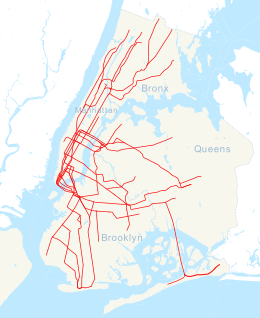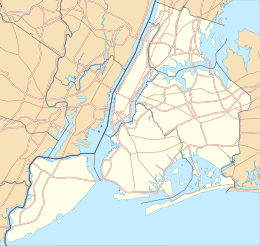railroad.wikisort.org - Station
The 40th Street–Lowery Street station (announced as simply 40th Street station on trains) is a local station on the IRT Flushing Line of the New York City Subway. It is served by the 7 local train at all times.
40 Street–Lowery Street | ||||||||||||||||||||||||||||||||||||||||||||||||||||||||||||||||||||
|---|---|---|---|---|---|---|---|---|---|---|---|---|---|---|---|---|---|---|---|---|---|---|---|---|---|---|---|---|---|---|---|---|---|---|---|---|---|---|---|---|---|---|---|---|---|---|---|---|---|---|---|---|---|---|---|---|---|---|---|---|---|---|---|---|---|---|---|---|
 | ||||||||||||||||||||||||||||||||||||||||||||||||||||||||||||||||||||
| Station statistics | ||||||||||||||||||||||||||||||||||||||||||||||||||||||||||||||||||||
| Address | 40th Street & Queens Boulevard Sunnyside, NY 11104 | |||||||||||||||||||||||||||||||||||||||||||||||||||||||||||||||||||
| Borough | Queens | |||||||||||||||||||||||||||||||||||||||||||||||||||||||||||||||||||
| Locale | Sunnyside | |||||||||||||||||||||||||||||||||||||||||||||||||||||||||||||||||||
| Coordinates | 40°44′37.72″N 73°55′27.04″W | |||||||||||||||||||||||||||||||||||||||||||||||||||||||||||||||||||
| Division | A (IRT)[1] | |||||||||||||||||||||||||||||||||||||||||||||||||||||||||||||||||||
| Line | IRT Flushing Line | |||||||||||||||||||||||||||||||||||||||||||||||||||||||||||||||||||
| Services | 7 | |||||||||||||||||||||||||||||||||||||||||||||||||||||||||||||||||||
| Transit | ||||||||||||||||||||||||||||||||||||||||||||||||||||||||||||||||||||
| Structure | Elevated | |||||||||||||||||||||||||||||||||||||||||||||||||||||||||||||||||||
| Platforms | 2 side platforms | |||||||||||||||||||||||||||||||||||||||||||||||||||||||||||||||||||
| Tracks | 3 | |||||||||||||||||||||||||||||||||||||||||||||||||||||||||||||||||||
| Other information | ||||||||||||||||||||||||||||||||||||||||||||||||||||||||||||||||||||
| Opened | April 21, 1917 | |||||||||||||||||||||||||||||||||||||||||||||||||||||||||||||||||||
| Opposite- direction transfer | No | |||||||||||||||||||||||||||||||||||||||||||||||||||||||||||||||||||
| Former/other names | Lowery Street | |||||||||||||||||||||||||||||||||||||||||||||||||||||||||||||||||||
| Traffic | ||||||||||||||||||||||||||||||||||||||||||||||||||||||||||||||||||||
| 2019 | 3,074,342[2] | |||||||||||||||||||||||||||||||||||||||||||||||||||||||||||||||||||
| Rank | 164 out of 424[2] | |||||||||||||||||||||||||||||||||||||||||||||||||||||||||||||||||||
| ||||||||||||||||||||||||||||||||||||||||||||||||||||||||||||||||||||
| ||||||||||||||||||||||||||||||||||||||||||||||||||||||||||||||||||||
| ||||||||||||||||||||||||||||||||||||||||||||||||||||||||||||||||||||
| ||||||||||||||||||||||||||||||||||||||||||||||||||||||||||||||||||||
| ||||||||||||||||||||||||||||||||||||||||||||||||||||||||||||||||||||
History
The Flushing Line was opened from Queensboro Plaza to Alburtis Avenue (now 103rd Street–Corona Plaza) on April 21, 1917, with a local station at 40th Street.[3]
The city government took over the IRT's operations on June 12, 1940.[4][5] The IRT routes were given numbered designations in 1948 with the introduction of "R-type" rolling stock, which contained rollsigns with numbered designations for each service.[6] The route from Times Square to Flushing became known as the 7.[7] On October 17, 1949, the joint BMT/IRT operation of the Flushing Line ended, and the line became the responsibility of the IRT.[8] After the end of BMT/IRT dual service, the New York City Board of Transportation announced that the Flushing Line platforms would be lengthened to 11 IRT car lengths; the platforms were only able to fit nine 51-foot-long IRT cars beforehand.[9][10] The platforms at the station were extended in 1955–1956 to accommodate 11-car trains.[11] However, nine-car trains continued to run on the 7 route until 1962, when they were extended to ten cars.[12] With the opening of the 1964 New York World's Fair, trains were lengthened to eleven cars.[13][14]
The present-day 33rd, 40th, and 46th Streets were originally respectively known as Rawson, Lowery, and Bliss Streets until the 1930s, when they were given numbered street names.[15] To avoid confusion, the 33rd Street–Rawson Street, 40th Street–Lowery Street, and 46th Street–Bliss Street stations displayed both the new and old names of the respective street.[16] Since a New York City Transit Authority rule prohibited subway stations from being named after nonexistent streets, the Metropolitan Transportation Authority (MTA) removed the old names of each street from station signs and subway maps in 1998. Local residents opposed the renaming and unsuccessfully attempted to persuade the MTA to restore the old names. The New York City Council passed a law in July 2003, giving both the old and new names to all three streets; after new street signs were installed in September 2003, the MTA agreed to restore the old names of each station.[15]
Station layout
| P Platform level | ||
| Side platform | ||
| Southbound local | ← | |
| Peak-direction express | ← | |
| Northbound local | | |
| Side platform | ||
| M | Mezzanine | Fare control, station agent, MetroCard machines |
| G | Street level | Entrances/exits |

The station has two side platforms and three tracks. The center track is used by peak-direction <7> express trains during rush hours.
The 1999 artwork featured at the station is called Q is for Queens by Yumi Heo.
Exit
The exit is under the tracks in the median of Queens Boulevard. The exit is at 40th Street with two stairs from each platform. Since fare control is on different sides of the exit, there is no free transfer between directions, although the station's layout could allow one.[17] This makes the station one of only two stations along the 7 (the other being Vernon Boulevard–Jackson Avenue) to not have a crossover or crossunder, as well as the only elevated station on the line that does not allow for free transfers between directions.
References
- "Glossary". Second Avenue Subway Supplemental Draft Environmental Impact Statement (SDEIS) (PDF). Vol. 1. Metropolitan Transportation Authority. March 4, 2003. pp. 1–2. Archived from the original (PDF) on February 26, 2021. Retrieved January 1, 2021.
- "Facts and Figures: Annual Subway Ridership 2014–2019". Metropolitan Transportation Authority. 2020. Retrieved May 26, 2020.
- "Transit Service on Corona Extension of Dual Subway System Opened to the Public". The New York Times. April 22, 1917. p. RE1. Retrieved October 2, 2011.
- "City Transit Unity Is Now a Reality; Title to I.R.T. Lines Passes to Municipality, Ending 19-Year Campaign". The New York Times. June 13, 1940. ISSN 0362-4331. Archived from the original on January 7, 2022. Retrieved May 14, 2022.
- "Transit Unification Completed As City Takes Over I. R. T. Lines: Systems Come Under Single Control After Efforts Begun in 1921; Mayor Is Jubilant at City Hall Ceremony Recalling 1904 Celebration". New York Herald Tribune. June 13, 1940. p. 25. ProQuest 1248134780.
- Brown, Nicole (May 17, 2019). "How did the MTA subway lines get their letter or number? NYCurious". amNewYork. Archived from the original on March 2, 2021. Retrieved January 27, 2021.
- Friedlander, Alex; Lonto, Arthur; Raudenbush, Henry (April 1960). "A Summary of Services on the IRT Division, NYCTA" (PDF). New York Division Bulletin. Electric Railroaders' Association. 3 (1): 2–3. Archived (PDF) from the original on September 14, 2020. Retrieved January 27, 2021.
- "Direct Subway Runs To Flushing, Astoria" (PDF). The New York Times. October 15, 1949. ISSN 0362-4331. Retrieved October 7, 2017.
- Bennett, Charles G. (November 20, 1949). "Transit Platforms On Lines In Queens To Be Lengthened; $3,850,000 Program Outlined for Next Year to Care for Borough's Rapid Growth New Links Are To Be Built 400 More Buses to Roll Also — Bulk of Work to Be on Corona-Flushing Route Transit Program In Queens Outlined". The New York Times. ISSN 0362-4331. Retrieved April 29, 2018.
- "37 Platforms On Subways To Be Lengthened: All Stations of B. M. T. and I.R.T.in Queens Included in $5,000,000 Program". New York Herald Tribune. November 20, 1949. p. 32. ISSN 1941-0646. ProQuest 1325174459.
- Minutes and Proceedings of the New York City Transit Authority. New York City Transit Authority. 1955. Archived from the original on September 13, 2020. Retrieved August 31, 2016.
- "R17s to the Flushing Line". New York Division Bulletin. Electric Railroaders' Association. 5 (6): M-8. December 1962 – via Issuu.
- "TA to Show Fair Train". Long Island Star – Journal. August 31, 1963. Retrieved August 30, 2016 – via Fulton History.
- "A First-class Rapid Ride". Railway Age. Vol. 156, no. 21. June 1, 1964. p. 22. ProQuest 895766286.
- O'Grady, Jim (September 7, 2003). "Neighborhood Report: Sunnyside; The Names Have Been Changed To Confuse the Innocent". The New York Times. ISSN 0362-4331. Retrieved May 22, 2022.
- Schneider, Daniel B. (May 4, 1997). "F.Y.I." The New York Times. ISSN 0362-4331. Retrieved May 22, 2022.
- "MTA Neighborhood Maps: Long Island City" (PDF). Metropolitan Transportation Authority. 2015. Retrieved September 27, 2015.
External links
 Media related to 40th Street – Lowery Street (IRT Flushing Line) at Wikimedia Commons
Media related to 40th Street – Lowery Street (IRT Flushing Line) at Wikimedia Commons- nycsubway.org – IRT Flushing Line: 40th Street/Lowery Street
- Station Reporter — 7 Train
- The Subway Nut — 40th Street–Lowery Street Pictures Archived September 24, 2019, at the Wayback Machine
- MTA's Arts For Transit — 40th Street–Lowery Street (IRT Flushing Line)
- 40th Street entrance from Google Maps Street View
- Platforms from Google Maps Street View
На других языках
- [en] 40th Street–Lowery Street station
[ru] 40-я улица — Лауэри-стрит (линия Флашинг, Ай-ар-ти)
«40-я улица — Лауэри-стрит» (англ. 40th Street–Lowery Street) — станция Нью-Йоркского метрополитена, расположенная на линии Флашинг, Ай-ар-ти. На станции останавливается маршрут 7 (круглосуточно). Станцию проходит без остановки маршрут <7> (в часы пик в пиковом направлении). Эстакадная станция с тремя путями и двумя боковыми платформами у боковых путей.Другой контент может иметь иную лицензию. Перед использованием материалов сайта WikiSort.org внимательно изучите правила лицензирования конкретных элементов наполнения сайта.
WikiSort.org - проект по пересортировке и дополнению контента Википедии



